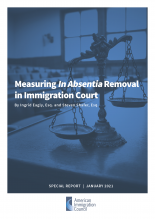- Special Report
Measuring In Absentia Removal in Immigration Court
Published
Do immigrants attend their immigration court hearings? This question is central to current debates about the immigration court system. Contrary to claims by the government that most immigrants fail to appear in immigration court, our analysis of data provided by the federal government reveals that 83% of all nondetained immigrants with completed or pending removal cases from Fiscal Years (FY) 2008 through 2018 attended all of their court hearings. Among those who were represented by counsel during the same time period, 96% attended all of their court hearings. Moreover, we reveal that 15% of those who were ordered deported because they didn’t appear in court successfully reopened their cases and had their removal orders rescinded. This crucial finding suggests that many individuals who fail to appear in court wanted to attend their hearings but never received notice or faced hardship in getting to court.
Key Findings
- 83% of nondetained immigrants with completed or pending removal cases attended all their hearings from 2008 to 2018.
- 96% of nondetained immigrants represented by a lawyer attended all of their hearings from 2008 to 2018.
- 15% of all removal orders for failure to appear issued from 2008 to 2018 were successfully overturned. In some years, as many as 20% of all orders of removal for missing court were later overturned.
- Individuals who applied for relief from removal have especially high rates of appearance.
- Appearance rates varied strongly based on the immigration court’s location.
- The Executive Office for Immigration Review’s method for measuring the rate at which immigrants fail to appear in court presents a limited picture of the frequency of missed court appearances.
This report presents these and other key findings from a recent study of the rate at which immigrants appear for hearings in U.S. immigration court. The findings stand in marked contrast to the bold and inconsistent claims made by former President Donald Trump and members of his administration about purportedly dismal court appearance rates. Indeed, former President Trump repeatedly shared misinformation that noncitizens never or rarely appear in court. Policymakers have relied on these assertions about purported failures to appear to drive key decisions, including to expand reliance on immigration detention and to reduce access to asylum. Appearance rates have also been pivotal to the debate about building a border wall, which the Trump administration sought to justify by claiming that those who cross the southern border simply “vanish” into the country and never come to court.
This report provides accurate information, based on independent analysis of government data, of the rate at which immigrants attend court. It sheds light on the concerted effort made by immigrants to comply with the law so as to increase transparency to policymakers and the public. The report provides a detailed analysis of the frequency of in absentia orders and discusses the important relationship between appearance rates and representation by counsel, applications for relief, and court location. Taken together, this data-driven report lays bare the lie that noncitizens never appear in court. It also serves as a necessary guide for the newly elected administration of President Joe Biden, which has the opportunity to take a fresh look at immigration policy and implement the data-driven policy recommendations discussed in the report’s conclusion.
Although much is at stake, government officials offer no verifiable empirical support for their claims that migrants “never” or rarely come to court. Therefore, scholars, members of the press, and other experts have turned to the annual report published by the statistical division of EOIR. The EOIR’s annual statistics yearbook has typically included a measurement of the in absentia removal rate but has offered only a sparse description of the method used to reach their measurement. This report offers an independent analysis of EOIR’s method for calculating in absentia removal and discusses the policy implications of these findings.
About the Data
This report analyzes the government’s own court records in immigration cases. Using the Freedom of Information Act (FOIA), these court records were obtained from the Executive Office for Immigration Review (EOIR), the division of the Department of Justice (DOJ) that conducts immigration court proceedings. EOIR periodically updates these data, and we analyzed data tables made available by EOIR as of November 2, 2018. These data included 8,253,223 immigration court proceedings, with completed and pending cases dating back to 1951.
To conduct the analysis, we limited our data to 2,797,437 nondetained removal proceedings from the period between fiscal years 2008 and 2018. These proceedings included both individuals who were never detained and those who were released from detention. Each of these immigration court proceedings contained one or more hearings.
For more information regarding the data and methodology used in this analysis, see Ingrid Eagly and Steven Shafer, “Measuring In Absentia Removal in Immigration Court,” University of Pennsylvania Law Review 168, no. 4 (2020): 817-876.
This report relies on the government’s own court data to provide reliable measurements of in absentia removal orders. Specifically, to calculate the rate at which immigrants have been ordered removed for failing to appear in court, we analyzed data released by EOIR, the agency within DOJ that contains the immigration courts. Because almost all in absentia orders take place in nondetained cases, we limited our analysis to those cases where the immigrant was never detained by ICE or had been detained and then released. In total, we analyzed 2,797,437 nondetained removal proceedings from the period between fiscal years 2008 and 2018.
We examined these data using three different analytical methods for calculating in absentia removal.
First, we replicated the method of calculating the in absentia rate generally used by EOIR in its annual statistics reports, which divides the number of in absentia removals issued at the initial case completion stage of a case by the total number of initial immigration judge decisions issued during the fiscal year. Initial immigration judge decisions are the first on-the-merits decisions by the immigration judge to order removal, grant relief, or terminate the case. This report refers to EOIR’s approach to measuring the in absentia rate as the “IJ decisions” method.
Second, we analyzed the rate at which immigrants were ordered removed for failure to appear among all cases which reached an initial case completion of any kind, including both initial immigration judge decisions and other immigration judge completions, such as administrative closures. Administrative closure is a discretionary docket-management tool that immigration judges have used for decades. Through this practice, a judge removes a case from the active docket, thereby putting the case on indefinite hold and allowing the noncitizen to remain in the United States. We call this the “all completions” method.
Third, we analyzed the rate at which immigrants were ordered removed for failure to appear as a percentage of both all initial case completions (including initial immigration judge decisions and other immigration judge completions) and pending cases. Pending cases are not yet resolved and have ongoing hearings to rule on motions and applications for relief. Pending cases ballooned from 156,714 in 2008 to 707,147 in 2018. This report calls this approach that includes pending cases the “all matters” method.
Table 1: In Absentia Removal Rate (Initial Case Completions),
by Method (Nondetained Only)
|
|
IJ Decisions |
Other |
In Absentia Removal Rate |
||||
|
Fiscal |
In Absentia |
Not In |
Other IJ Completions |
Pending |
IJ Decisions |
All |
All |
|
2008 |
24,882 |
60,337 |
8,020 |
144,996 |
29% |
27% |
8% |
|
2009 |
22,071 |
57,640 |
6,803 |
178,156 |
28% |
26% |
6% |
|
2010 |
23,852 |
64,357 |
7,883 |
212,053 |
27% |
25% |
6% |
|
2011 |
21,739 |
65,417 |
5,235 |
246,153 |
25% |
24% |
5% |
|
2012 |
18,990 |
60,344 |
14,994 |
275,132 |
24% |
20% |
4% |
|
2013 |
20,940 |
56,727 |
27,243 |
303,015 |
27% |
20% |
4% |
|
2014 |
25,587 |
46,655 |
29,845 |
372,884 |
35% |
25% |
5% |
|
2015 |
37,994 |
45,467 |
41,003 |
393,651 |
46% |
31% |
6% |
|
2016 |
33,896 |
47,579 |
47,071 |
443,658 |
42% |
26% |
5% |
|
2017 |
41,374 |
45,684 |
28,055 |
559,855 |
48% |
36% |
5% |
|
2018 |
44,764 |
63,975 |
9,046 |
673,580 |
41% |
38% |
5% |
|
Summary Statistics |
|||||||
|
Total |
316,089 |
614,182 |
225,198 |
673,580 |
34% |
27% |
17% |
|
Average |
28,735 |
55,835 |
20,473 |
345,739 |
34% |
27% |
5% |
|
(SD) |
(9,092) |
(7,990) |
(14,877) |
(163,990) |
(8%) |
(6%) |
(1%) |
Source: Authors’ analysis of Executive Office for Immigration Review data, FY 2008–2018
Table 1 provides the findings from this analysis. Each of these three methods yielded a different in absentia rate for nondetained immigrants during the period from 2008 to 2018.
- First, using the government’s IJ decisions method, the in absentia rate was 34%.
- Second, using the all completions method, the in absentia rate was 27%.
- Third, using the all matters method, the in absentia rate was 17%.
When the same data were analyzed using the government’s IJ decisions method, nondetained immigrants appear to miss court much more often. The government measurement is twice as high as the all matters approach—34% of the time compared to just 17% of the time. That means that under the all matters approach, immigrants have appeared for all scheduled hearings in 83% of all pending and completed cases over an 11-year period.
Of the three methods, the all matters method is the most reliable measurement of the rate at which immigrants appear in court. First, unlike the government’s IJ decisions method, the all matters method includes all judicial decisions, including decisions to administratively close a case, in its analysis. Because administrative closure reached a rate as high as one-fourth of all initial case completions from 2008–2018, the failure to include such closures makes the government method significantly less inclusive of what is happening in immigration court.
Second, unlike the government’s IJ decisions method, the all matters method includes pending cases. If immigration cases were quickly decided on their merits, excluding pending cases when measuring the in absentia removal rate—as EOIR does—might make sense. But given the immense and growing backlog in the immigration courts, cases can drag on for many years before a decision is reached. During this time, immigrants who diligently are attending all of their court hearings should not be excluded from calculations of appearance rates.
Because the government’s IJ decisions method excludes pending cases, it does not account for the hundreds of thousands of cases each year in which immigrants appear for a hearing while their case wends its way through the lengthy court process. Given the flaws with the government’s IJ decisions method, and its tendency to overstate the rate at which immigrants fail to appear in court, we recommend against the method’s use whenever possible.
Figure 1: In Absentia Removal Rate, by Calculation Method (Nondetained Only)
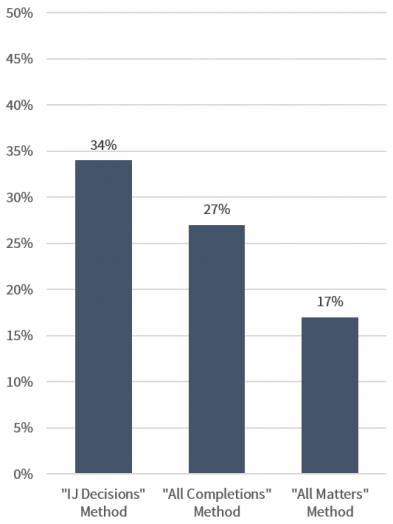
Source: Authors’ analysis of Executive Office for Immigration Review data, FY 2008–2018
The immigration court compliance rates discussed above reveal that the vast majority of immigrants have attended their court hearings. For those who do miss their hearings, a crucial question is whether they were made aware of their court date and time in accordance with due process. Indeed, court appearance rates must be considered against the backdrop of a pervasive failure of DHS to include the time and date of hearings in the charging documents given to individuals in removal proceedings. In a 2018 oral argument before the U.S. Supreme Court, counsel for the government admitted that “almost 100%” of notices to appear issued over the previous three years had omitted the time and date of the court proceeding. These pervasive defects in notice are part of the reason why noncitizens do not appear in court. This reality has made it hard for individuals—particularly if they do not speak English, are unfamiliar with the court system, or do not have lawyers—to figure out when and where to go to court.
To address these notice deficits, we evaluated how often immigration judges identified failures to appear that occurred because of notice issues. Looking at the cases of individuals who were never detained, we found that immigration judges adjourned fewer than 1% of initial hearings due to potential notice issues. However, when judges did adjourn these missed hearings due to notice issues, we found that 54% of these individuals appeared in court at the next hearing.
This is an essential data point. First, it reveals that, although notice issues were prevalent during the time period of this study and the government has the burden to prove proper service of notice, notice issues were rarely identified or challenged by immigration judges. Second, it demonstrates that when immigration judges did pay attention to notice issues, the majority of noncitizens made it to court after the notice issue was addressed.
Each immigration proceeding contains one or more hearings. The first hearings in a case are generally referred to as “initial master” hearings (also commonly known as “master calendar” hearings), which are scheduled to allow for general administration of the case, including the taking of pleadings, requests for time to find an attorney or time to prepare a case, and the filing of applications for relief. Some cases proceed on to an “individual” hearing (also commonly known as “merits” hearing) in which the immigration judge adjudicates the substance of the claim for relief, such as asylum or cancellation of removal.
As seen in Figure 2, 47% of in absentia removal orders occurred at the very first hearing in the case. The pattern was very different among initial case completions that did not result in an in absentia order. Less than 9% of non-in absentia decisions were completed at the first hearing. These patterns, along with the other data reported above, suggest that some immigrants who fail to appear at their first hearing may not have received notice about the court proceeding.
Figure 2 also reveals that once individuals have begun the court process, they were more likely to appear in court. In other words, the more an immigrant becomes invested in the court process through awareness of how the system works and familiarity with the procedural requirements, the less likely the person is to fail to appear.
Figure 2: Number of Hearings Before Initial Case Completion, by Decision Type (Nondetained Only)
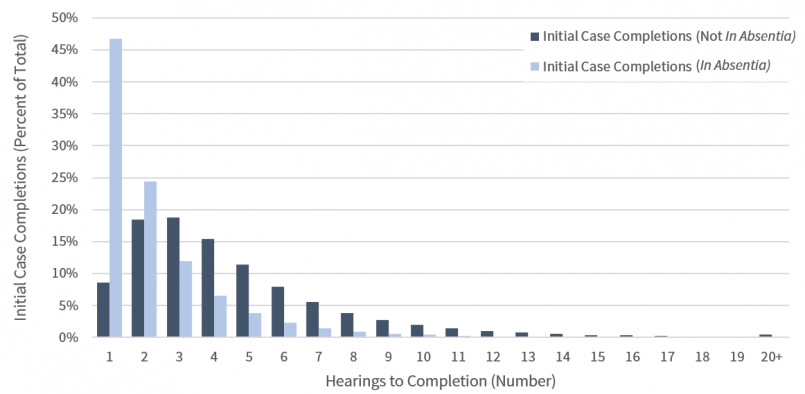
Source: Authors’ analysis of Executive Office for Immigration Review data, FY 2008–2018
Immigrants may overturn a removal order for failure to appear in court in two specific circumstances, both of which require the immigrant to prove they did not intentionally or negligently fail to appear:
- When a motion to reopen is filed within 180 days of the order of removal, demonstrating that “exceptional circumstances” prevented the immigrant from appearing in court and led to the failure to appear.
- When the immigrant can prove that they never received notice of the scheduled hearing.
We relied on the EOIR data to examine what happened after the initial in absentia order was entered. From 2008 to 2018, nearly 20% of all in absentia removal orders were challenged through a motion to reopen. These motions were overwhelmingly successful, and fully 15% of those who were ordered removed in absentia during that period successfully reopened their cases and had their deportation orders rescinded (see Figure 3 & Table 2). This crucial finding suggests that many individuals who failed to appear in court wanted to attend their hearings but never received notice or faced hardship in getting to court.
Figure 3: Rate at Which In Absentia Orders Are Overturned, by Fiscal Year Order of Removal Order Entered (Nondetained Only)
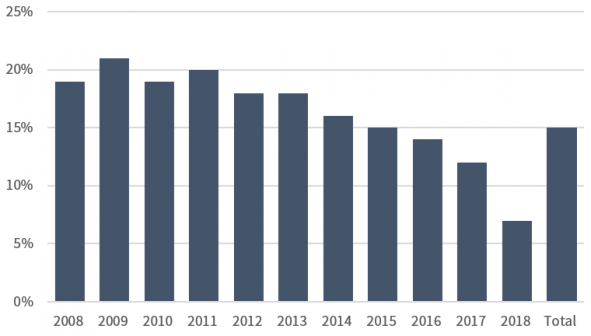
Source: Authors’ analysis of Executive Office for Immigration Review data, 2008–2018
Table 2: Reopening of In Absentia Removal Orders, by Fiscal Year (Nondetained Only)
|
Fiscal Year |
In Absentia Removal |
Successful |
Reopened |
|
2008 |
24,882 |
4,716 |
19% |
|
2009 |
22,071 |
4,560 |
21% |
|
2010 |
23,852 |
4,651 |
19% |
|
2011 |
21,739 |
4,331 |
20% |
|
2012 |
18,990 |
3,464 |
18% |
|
2013 |
20,940 |
3,799 |
18% |
|
2014 |
25,587 |
4,188 |
16% |
|
2015 |
37,994 |
5,558 |
15% |
|
2016 |
33,896 |
4,589 |
14% |
|
2017 |
41,374 |
4,812 |
12% |
|
2018 |
44,764 |
3,284 |
7% |
|
Total |
316,089 |
47,952 |
15% |
Source: Authors’ analysis of Executive Office for Immigration Review data, FY 2008–2018
In reviewing Figure 3, note how older cases had a higher rate of reopening than newer cases. For cases that received an in absentia order in 2008, 19% were reopened by the end of our study period. In contrast, only 7% of in absentia orders entered in 2018 had been reopened at the end of 2018. This outcome makes sense given that many individuals with in absentia orders may not yet be aware that they were ordered removed and need time to make a motion to reopen in immigration court. Given the legal complexity of such a motion, individuals may also need time to find and retain counsel. Over time, therefore, we can expect the percentage of in absentia cases that are reopened to rise.
We also analyzed three factors associated with showing up in immigration court: having a lawyer, applying for relief from removal, and court location.
Attorney Involvement
Noncitizens have a right to be represented by counsel in immigration proceedings, but generally not at the expense of the government. To evaluate the relationship between representation and in absentia removal rates, we examined the rate of in absentia removals among those who had counsel between 2008 and 2018.
The data reveal that individuals with counsel rarely failed to show up in court. Even using the government’s IJ decision method, persons with counsel were ordered removed in absentia just 8% of them time. When using the all matters method, those with counsel were ordered removed in absentia in just 4% of cases (see Figure 4).
Figure 4: In Absentia Removal Rate for Individuals Represented by Counsel, by Calculation Method (Nondetained Only)
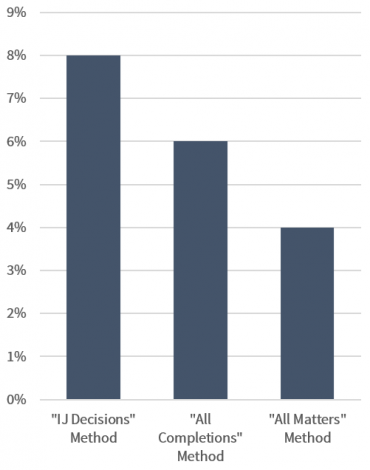
Source: Authors’ analysis of Executive Office for Immigration Review data, FY 2008–2018
We also find that most cases with failures to appear involved unrepresented litigants. Overall, only 15% of those who were ordered removed in absentia during our study period had an attorney. By contrast, 86% of those with an initial completion not ending in absentia had counsel (see Figure 4).
We also find that the ability to reopen an in absentia removal case is mainly reserved for those who find a lawyer. That is, among those who were able to successfully reopen their case after an in absentia removal order, 84% had a lawyer representing them.
As these striking statistics suggest, attorneys play a vital supporting role in ensuring that their clients make it to court. Attorneys can make sure their client knows when and where to appear and how to keep the court updated on any change of address. Without a lawyer, some immigrants attend their check-in appointments with ICE believing erroneously that it is their court date and then miss their actual court date. Others have reported missing their hearings after being given Notices to Appear (NTAs) with no court date or with a fake court date at an erroneous location. Unrepresented litigants may also encounter challenges in completing the necessary court documents to reschedule an immigration court hearing or to notify the court about a change of address. For example, despite policy to the contrary, immigration courts do not always accept notifications of changes of address before proceedings have formally begun, making it impossible to receive notice at a new address.
Applying for Relief
Immigration removal proceedings are best understood as occurring in two stages. In the first stage, the immigration judge decides whether to sustain the charge of removability alleged by DHS in the NTA against the individual, who is referred to in immigration court as the “respondent.” If the charge is sustained and the respondent is found to be subject to removal, the respondent can seek relief from removal in the second stage. There are numerous forms of relief in immigration court. The most commonly sought are asylum, cancellation of removal, and adjustment of status. To qualify for relief, a respondent must satisfy the applicable statutory eligibility requirements and convince the judge that the case merits the favorable exercise of discretion. A respondent who wins relief will be able to remain lawfully in the United States.
Across the 11 years of our study period, 48% of individuals in removal proceedings who were not detained sought some form of relief prior to the initial completion in their cases. Among these individuals who sought relief, 72% submitted an asylum application; 28% applied for cancellation of removal for lawful permanent residents or non-lawful permanent residents; and 10% applied for adjustment of status.
Overall, 95% of all litigants with completed or pending applications for relief attended all of their court hearings between 2008 and 2018. This result makes sense: individuals pursuing claims for relief in court have a strong incentive to fight for permission to remain in the United States.
Figure 5: In Absentia Removal Rate, by Application Type and Calculation Method (Nondetained Only)
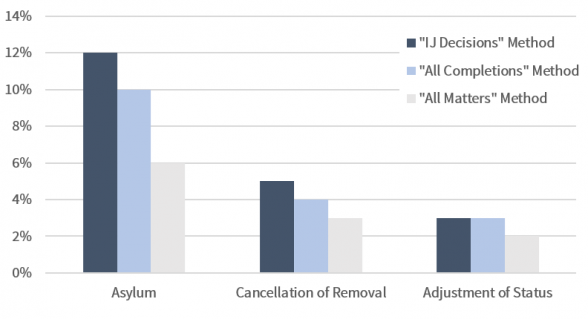
Source: Authors’ analysis of Executive Office for Immigration Review data, FY 2008–2018
Figure 5 presents the in absentia rates for nondetained respondents who sought relief in immigration court, organized by the most common types of relief (asylum, cancellation of removal, and adjustment of status). We present these findings using all three possible measurements for in absentia removal: as percentages of all initial immigration judge decisions on the merits, all initial case completions, and all matters. Focusing on the all matters approach, only 6% of those seeking asylum failed to appear during the study period, while only 3% of those seeking cancellation of removal and 2% of those seeking adjustment of status did.
These findings are noteworthy because they reveal that immigrants seeking relief are highly likely to come to court. Such statistics have not traditionally been released by the federal government, which generally provides only overall rates—not rates among those seeking relief from removal.
Court Location
The in absentia rate also varied by court location. Currently, there are more than 60 different cities in the United States that host immigration courts, and approximately 460 immigration judges appointed by the attorney general of the United States. As seen in Table 3, the variation in in absentia removal rates by city was striking, ranging from a high of 54% in Harlingen, Texas, to a low of 15% in New York City. The three courts that handled the highest numbers of cases involving individuals who were not detained—San Francisco, Los Angeles, and New York—also had among the lowest in absentia removal rates.
Some of these differences across jurisdictions no doubt reflect different migrant populations at these court locations. In column 3 of Table 3 we calculate by jurisdiction the percentage of nondetained initial case completions that involved respondents who were never detained (as opposed to being released from detention). In Harlingen, Texas, for example, only 20% of initial case completions were for never-detained respondents; the remaining 80% were for individuals who were released from detention. Interestingly, however, there was still wide variation in the in absentia removal rates across cities with similar proportions of never-detained cases. For example, approximately two-thirds of the dockets in both San Francisco and Dallas were composed of cases of individuals who were never detained, but the in absentia removal rate in San Francisco was 19%, compared to 41% in Dallas.
Table 3: In Absentia Removal as a Percentage of Initial Case Completions, by Court Location (Nondetained Only)
|
City |
Initial Case Completions |
Never-Detained |
Active IJs (2008-2018) |
In Absentia Rate |
|
Harlingen, TX |
16,535 |
20% |
8 |
54% |
|
Houston, TX |
46,691 |
56% |
17 |
46% |
|
New Orleans, LA |
17,633 |
53% |
12 |
45% |
|
Charlotte, NC |
36,619 |
78% |
4 |
44% |
|
San Antonio, TX |
26,444 |
19% |
16 |
42% |
|
Dallas, TX |
34,193 |
69% |
9 |
41% |
|
Chicago, IL |
41,253 |
60% |
13 |
38% |
|
Memphis, TN |
26,225 |
75% |
7 |
36% |
|
Atlanta, GA |
37,845 |
66% |
10 |
35% |
|
Arlington, VA |
41,022 |
67% |
15 |
33% |
|
Baltimore, MD |
33,407 |
76% |
9 |
33% |
|
Orlando, FL |
39,334 |
79% |
9 |
29% |
|
Philadelphia, PA |
20,015 |
73% |
8 |
28% |
|
Kansas City, MO |
17,862 |
57% |
13 |
28% |
|
Cleveland, OH |
14,423 |
60% |
11 |
28% |
|
Newark, NJ |
30,641 |
65% |
18 |
27% |
|
Miami, FL |
85,383 |
77% |
37 |
26% |
|
Boston, MA |
33,517 |
73% |
12 |
24% |
|
Denver, CO |
18,722 |
57% |
10 |
23% |
|
Los Angeles, CA |
135,393 |
74% |
54 |
23% |
|
Seattle, WA |
22,113 |
61% |
5 |
19% |
|
San Francisco, CA |
59,257 |
68% |
31 |
19% |
|
San Diego, CA |
18,583 |
50% |
10 |
17% |
|
Phoenix, AZ |
25,140 |
42% |
5 |
16% |
|
New York, NY |
149,444 |
76% |
48 |
15% |
Source: Authors’ analysis of Executive Office for Immigration Review data, FY 2008–2018
This deviation in appearance rates may also reflect differences in local court practices. For example, some local courts may have better and more timely systems in place for scheduling court hearings and notifying respondents about their upcoming court hearings. A 2017 DOJ on-site review of the immigration court in Baltimore, Maryland, found that the court was so understaffed as caseloads grew that administrators were unable to enter change-of-address paperwork sent to the court into their computer system. This problem means that respondents would not receive their court notices, which the report warned “can result in respondents being ordered removed [for failure to appear in court] through no fault of their own.” As our data reveal, 33% of respondents in the Baltimore court were ordered removed for failure to appear.
Another court practice that is associated with whether respondents came to court is the length of delay between the issuance of the NTA and the initial court date. Looking only at all initial case completions among never detained, we found that the average time between the filing of the NTA and the initial hearing was 239 days for cases that ended with in absentia orders. By comparison, on average there were only 167 days between the filing of the NTA and the first hearing in never-detained cases that did not end with in absentia removals. The median number of days showed similar patterns: 153 days median for cases ending in absentia, compared to 101 days median for cases not ending in absentia. This finding suggests that, on average, long delays can make it harder for people to receive proper notice, remember their court hearings, and remain in contact with the court.
The availability of counsel in different jurisdictions may be an additional contributing factor to variation in failures to appear. In previous work, we found that some cities have very few practicing immigration attorneys. These problems were most acute in smaller cities where detained courts tend to be located. For example, we found that Lumpkin, Georgia, where the Stewart Detention Center is located did not have a single practicing immigration lawyer in 2015, and Oakdale, Louisiana, had only four. As a result, the rate of attorney representation also varies dramatically between immigration courts.
Notably, those cities with the highest in absentia removal rates using the all case completions method also had the lowest representation rates (Table 3). For example, in Harlingen, Texas, where 54% of nondetained respondents were ordered removed for failing to appear, only 41% of nondetained respondents had counsel. In sharp contrast, 85% of nondetained respondents in New York City’s immigration court had counsel, and only 15% were removed for not appearing in court.
In summary, attorney representation, seeking relief, and court assignment were all associated with variation in in absentia removal rates. Individuals who filed claims for relief (such as asylum or cancellation of removal) were very unlikely to miss court: 95% attended all of their court hearings over the 11 years of our study in pending and completed nondetained cases. Those who obtained lawyers also almost always came to court: 96% attended all court hearings in pending and completed nondetained cases. In addition, the prevalence of in absentia removals varied widely based on court location, ranging from a low of 15% of all initial case completions in New York City, to a high of 54% in Harlingen, Texas.
A key insight of this report is that the method chosen for measuring failures to appear in court matters. As we have set forth, the method adopted by the government to measure annual rates of in absentia removals—as a percentage of initial immigration judge decisions on the merits—ignores a large number of court cases in which respondents have not missed any court hearings. In particular, the government’s measurement ignores cases that are administratively closed, an essential tool that has been used by immigration judges over the past decade to remove cases indefinitely from the immigration court’s docket. The government’s measurement also ignores the historically high number of backlogged cases pending in immigration courts today. These backlogs matter because nondetained deportation cases now take many court hearings and several years to resolve, and during this time immigrants continue to appear for their court hearings. This report has argued that counting administrative completions and pending cases in the in absentia removal measurement is a necessary complement to the government’s measurement that enhances public understanding of the rate at which noncitizens are complying with their court dates. We recommend that future statistical reporting by EOIR include these measurements.
The analysis of over a decade of government data presented here also has immediate relevance to the consideration of policy questions in which statistics on failures to appear in court play a central role. The findings presented in this report are particularly important as the new administration of President Joe Biden considers how to reform the immigration system, including the immigration courts. The “timely and fair” adjudication of asylum and other cases by immigration judges is a vital component of the Biden plan “for securing our values as a nation of immigrants.”
In particular, this report supports four meaningful policy reforms:
- reducing reliance on detention and programs such as the Migrant Protection Protocols (MPP) that keep asylum seekers in Mexico while awaiting court hearings;
- ensuring access to counsel for individuals in removal proceedings;
- reforming the in absentia law and enhancing judicial training; and
- establishing an independent Article I immigration court.
First, our finding that the vast majority of nondetained respondents attended their court hearings supports releasing far more people from custody rather than creating stricter detention rules and expanded detention capacity. Further improvement in court appearance rates could also be attained by learning from the proven success of other court systems in providing reminder calls, postcards, and text messages with the accurate time and date of the hearing. In addition, ICE could ensure that individuals who are scheduled for agency check-ins are educated on the court process and provided transportation assistance to court if necessary. Our analysis showing that asylum seekers are very likely to attend their court hearings similarly undermines arguments that asylum seekers should be prevented from entering the country out of a fear they will not come to court.
Second, further enhancements in appearance rates could be fostered by expanding funding for pro bono lawyers and know-your-rights programs. Our data show that individuals with attorneys have near-perfect attendance rates. Over the 11 years of our study, 96% of represented individuals in completed or pending courts attended all of their court hearings (Figure 4).
Third, this report’s findings support giving immigration judges greater independence and training to give individuals a second chance to come to court. Our independent analysis of federal data reveals that in those cases where individuals were given another opportunity to come to court, more than half did show up at the next hearing. One significant reform along these lines would be to amend the immigration law to give judges greater discretion to provide immigrants more chances to come to court, as the law allowed prior to 1990. Even if the law is not changed, EOIR could work to train judges to more carefully scrutinize notice issues at the first hearing to ensure that proper notice was provided before issuing any removal orders, making sure that DHS has met its burden to prove by clear, unequivocal, and convincing evidence that a person has received proper notice.
Finally, this report supports the creation of an independent structure for the immigration courts. The federal tax and bankruptcy courts provide precedent for creating specialized federal courts under Article I of the United States Constitution. Such an independent court structure would help to reduce the prevalence of unwarranted in absentia removal orders by giving immigration judges more authority over their dockets and individual case decisions. As an independent court, judges would feel less pressure to meet case quotas and approve removal orders, allowing them to focus proper attention on notice deficiencies. Judges would also have more flexibility to use court continuances to give respondents further opportunity to come to court.
Help us fight for immigration justice!
The research is clear – immigrants are more likely to win their cases with a lawyer by their side. But very few can get attorneys.
Introducing the Immigration Justice Campaign Access Fund.
Your support sends attorneys, provides interpreters, and delivers justice.

Immigration Justice Campaign is an initiative of American Immigration Council and American Immigration Lawyers Association. The mission is to increase free legal services for immigrants navigating our complicated immigration system and leverage the voices and experiences of those most directly impacted by our country’s immigration policies to inform legal and advocacy strategies. We bring together a broad network of volunteers who provide legal assistance and advocate for due process for immigrants with a humane approach that includes universal legal representation and other community-based support for individuals during their immigration cases.

